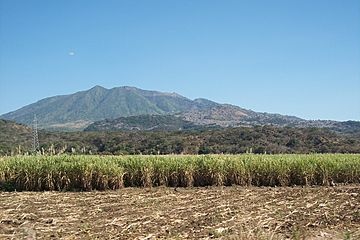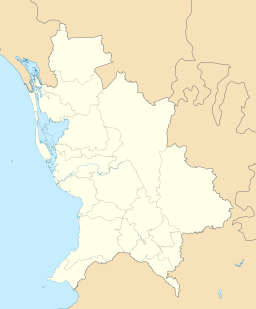Ceboruco facts for kids
Quick facts for kids Ceboruco |
|
|---|---|

Ceboruco volcano
|
|
| Highest point | |
| Elevation | 2,280 m (7,480 ft) |
| Listing | List of volcanoes in Mexico |
| Geography | |
| Geology | |
| Mountain type | Stratovolcano |
| Volcanic belt | Trans-Mexican Volcanic Belt |
| Last eruption | 1870-75 |
Ceboruco is a large, cone-shaped volcano located in Nayarit, Mexico. It is part of a chain of volcanoes called the Trans-Mexican Volcanic Belt. This volcano is known as a stratovolcano, which means it's built up over time by many layers of hardened lava and ash.
Contents
What Makes Ceboruco Special?
Ceboruco is a dacitic stratovolcano. This means its lava is thick and sticky, often leading to explosive eruptions. The volcano has a huge bowl-shaped hollow called a caldera. This caldera formed when the volcano's top collapsed after a massive eruption. Inside this large caldera, there's a smaller crater. This smaller crater formed when a lava dome collapsed during another eruption.
Explosive Features Inside the Craters
Inside both the main caldera and the smaller crater, you can find several interesting volcanic features. These include:
- Scoria deposits: These are pieces of dark, bubbly volcanic rock, like tiny bits of hardened lava foam.
- Lava domes: These are mounds formed when thick lava slowly oozes out and piles up around the vent.
- Pyroclastic domes: Similar to lava domes, but made of fragments of rock and ash.
- Cinder cone volcanoes: These are small, steep cones built from volcanic ash and cinders.
Ceboruco's Eruption History
Ceboruco has had several eruptions over thousands of years. The cooled lava flows around the volcano act like a timeline, showing us its past activity.
The Jala Plinian Eruption
The biggest eruption from Ceboruco was called the Jala Plinian eruption. This happened around 930 AD. A Plinian eruption is a very powerful and explosive type of eruption, similar to the one that destroyed Pompeii. This eruption was rated a VEI 6. The VEI (Volcanic Explosivity Index) is a scale that measures how big volcanic eruptions are. A VEI 6 eruption is very large! It released about 11 cubic kilometers of tephra, which is a mix of ash, pumice, and rock fragments. This huge eruption created the main caldera we see today.
Active Times After Jala
For about 500 years after the Jala eruption, Ceboruco was very active. During this time, six major lava flows occurred:
- The Copales flow
- The El Cajón flow
- The Coapan I flow
- The Coapan II flow
- The El Norte flow
- The Ceboruco flow
All these eruptions happened before the Spanish arrived in Mexico in 1521.
The 1870-1875 Eruption
The most recent eruption of Ceboruco happened between 1870 and 1875. This eruption is the best documented one. Even after the lava stopped flowing, the volcano continued to show activity. Fumarole activity, which is when steam and gases escape from cracks in the ground, continued well into the 20th century.
What is Ceboruco's Lava Made Of?
The lava that comes out of Ceboruco is mainly a type called trachydacite to trachyandesite. Over time, the lava has changed from being more andesitic (a common type of volcanic rock) to more dacitic (a thicker, stickier type). Scientists believe the magma, which is molten rock inside the Earth, comes from a mix of three different sources deep underground.
See also
 In Spanish: Ceboruco para niños
In Spanish: Ceboruco para niños



